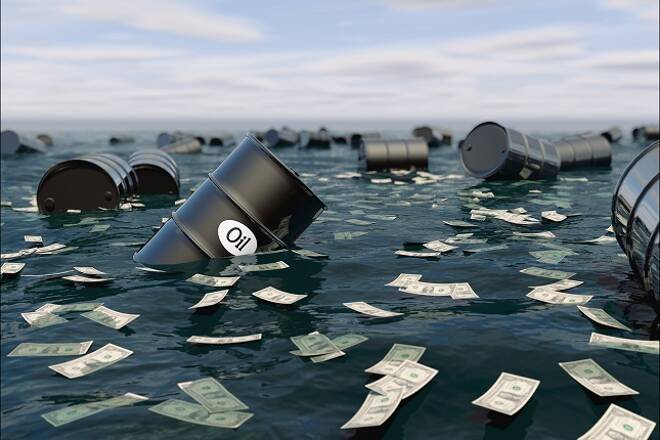Advertisement
Advertisement
Oil Price Fundamental Weekly Forecast – Iran Sanctions Begin, Nearby WTI Closes Below 200-D Moving Average
By:
If the U.S. and China reach a trade agreement then look for a strong short-covering rally. In this case, buyers will be willing to pay up for crude oil. The market will then turn bullish over the 200-day moving average at $66.12. Crude oil will strengthen further on the weekly chart over $66.72. If there is no deal then the 200-day moving average will be resistance and prices will continue to move lower until buyers find value.
“Oily to bed, Oily to rise” made a crude oil bear wealthy in October if he was wise enough to buck the trend and all the talk of a supply shortage to short the market ahead of reports of oversupply.
Nearby WTI crude oil futures hit a multi-year high on October 3 at $76.85 then proceeded to sell-off the entire month. Even breaking the 200-Day Moving Average at $66.12 for the first time since October 20, 2017.
For the week, December WTI Crude Oil futures settled at $63.14, down $4.45 or -6.58% and January Brent Crude Oil futures finished at $72.83, down $4.83 or -6.63%.
WTI and Brent crude oil opened November under continued selling pressure. Traders placed the blame for the weakness on a number of factors including the strong U.S. Dollar, stock market volatility and weakness, the escalating trade dispute between the United States and China, and rising global supply. The narrative that the market was “fragile” and that there were spare capacity issues seemed to disappear overnight. Instead, the focus shifted to the possibility that the market was oversupplied.
Last week, the U.S. Dollar hit a 16-month high against a basket of major currencies. This made crude oil more expensive for foreign buyers, driving down demand.
The steep sell-off in the U.S. equity markets and heightened volatility also weighed on crude oil prices. The tight relationship between stocks and crude may have led hedge funds to dump positions due to margin calls, further accelerating the sell-off.
The issue over the escalating trade dispute between the United States and China came up again in October. This time it was being blamed for weakness in emerging market economies and currencies. Institutions like the International Energy Agency cut forecasts for oil demand this year and next because of growing threats to global economic growth, yet it also warned that dwindling spare oil supplies will keep prices high.
“Expensive energy is back” and “it poses a threat to economic growth,” said the IEA, which advises most major economies. “For many developing countries, higher international prices coincide with currencies depreciating against the U.S. dollar, so the threat of economic damage is more acute.”
Finally, as the bearish factors continued to pile up in October, the issue of oversupply was raised. According to the latest reports, Russia pumped 11.41 million bpd of crude in October, a 30-year high. The U.S. Energy Information Administration reported that U.S. production is now well over 11 million bpd. OPEC reported oil production in October jumped to 33.31 million bpd. Those three countries are now producing about a third of daily global demand.
Forecast
The sanctions against Iran begin on November 4. Now traders start to see the real effect on global supply. Is there going to be a shortage? Is there going to be a surplus? We’ll soon find out.
Sellers dumped crude oil last week into the close so there is no question that traders are going into the start of the sanctions holding on to short positions. In other words, they are betting on an oversupply.
Just like farmers say, “Nothing cures high prices like high prices”, we can say that “Nothing cures low prices like low prices”. This is because the market will eventually find a value area once the professionals can determine the actual shortage in the global market from the sanctions.
I think the oversupply situation can be taken care of pretty quickly, one or all of the major producers – Saudi Arabia, the U.S. and Russia – will start to cut back on production if prices get too cheap.
Demand worries are an issue because they are based on perception, not real numbers yet. Living in the U.S., I don’t see an economic slowdown. Demand concerns will go away if we start to see improvement in the global economy. Just look at what the emerging markets did last week when Bloomberg announced a possible trade deal.
The obvious wild card is the end to the U.S. – China trade dispute.
If the U.S. and China reach a trade agreement then look for a strong short-covering rally. In this case, buyers will be willing to pay up for crude oil. The market will then turn bullish over the 200-day moving average at $66.12. Crude oil will strengthen further on the weekly chart over $66.72.
If there is no deal then the 200-day moving average will be resistance and prices will continue to move lower until buyers find value.
About the Author
James Hyerczykauthor
James Hyerczyk is a U.S. based seasoned technical analyst and educator with over 40 years of experience in market analysis and trading, specializing in chart patterns and price movement. He is the author of two books on technical analysis and has a background in both futures and stock markets.
Latest news and analysis
Advertisement
